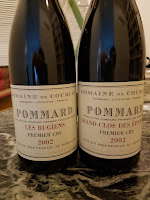31 May 2017:
 |
| Source: www.bourgogne-wines.com |
Once a spa town of great renown in the mid 19th Century, Santenay’s waters with high lithium content were supposed to have superb healing powers. Amidst current discussions of reviving this attraction for the quiet village of Santenay, its wines are gaining increased recognition for their consistent quality, charm and ageability, while remaining relatively accessible for those with moderate budgets.
The lesser-known village of Santenay lies approximately 20 km south of Beaune, at the southern tip of the Côte de Beaune, abutting Chassagne-Montrachet on the northeastern side and Les Maranges on the southwestern side. From the panoramic vantage point atop the Montagne des Trois Croix (521 metres) at the western end, one can appreciate vinous Santenay being made up of three distinct groups of vineyards, each presenting different styles and altitudes, across the 320 hectares under production.
The prevalence of limestone has much to do with the style of wines from Santenay. The bedrock is predominantly oolitic limestone, same as in Gevrey-Chambertin in the Côte de Nuits. This well-drained limestone bedrock is mostly covered by marl, and overlaying the marl is a thin layer of scree and clay rich in iron oxide. Santenay is a landscape full of faultlines and crevices, as a result of numerous ancient geological shifts. This has enriched the diversity of its wines, with variety of soils, orientations and microclimatic conditions, giving unique organoleptic qualities to its 12 premier cru climats and numerous lieux-dits.
At the northern end near Chassagne-Montrachet, is a large group of vineyards rising from 200 metres at the foot of the hill to 360 metres, featuring the premier cru climats of La Comme, Les Gravières and Beauregard, amongst others. The famous windmill of Santenay is located inside Beauregard. The wines here are aromatic, full-bodied, elegant with a fine structure. The central part of Santenay, or the western part, is the home to two well-known premier cru climats, La Maladière and Beaurepaire, reaching the heights of almost 400 metres. A famous landmark in this part is the Château of Philippe Le Hardi (Philip the Bold) dating to the 14th Century, the height of Valois Duke rule. Here the wines are rich, aromatic, with great finesse. The southern part rises from 230 metres to an altitude of 450 metres at the lieu-dit of Les Bras, the highest for a village appellation in Bourgogne. We find the premier cru climats of Petit Clos Rousseau, Grand Clos Rousseau and Les Fourneaux here. The soil is deep, producing masculine style wines of great tannic structure and ageability.
Apart from being the seat of Philippe Le Hardi, Santenay boasts one other illustrious inhabitant – Jacques-Marie Duvault-Blochet who acquired the vineyard of Romanée-Conti in 1868 from the Ouvrard family.
Santenay largely produces red wine, with 79% of its production in red and the remainder in white. Of the 280 ha of red production, about 100 ha are planted for premier cru production. Of the 50 ha of white production, about 13ha produce premier cru quality white wine.
Santenay may be lesser-known in some export markets but judging by the quality of the wines featured at the live broadcast masterclass hosted by the Bourgogne Wine Board, the wines from Santenay are no shy violets. They deliver expression of terroir, sense of place, consistency, class, power in some cases, and complete with much charm, generosity and character. Antoine Olivier of Domaine Antoine Olivier described the whites of Santenay as Superman, discreet like Clark Kent during the day, but powerful and complex underneath. Frédéric Barnier, Technical Manager of Maison Louis Jadot, recalled the amazing youthfulness of a 1996 Santenay that he recently tasted from the winery cellar that attested to the ageability of Santenay.
We tasted the following wines:
2013 Santenay Clos de Malte, Maison Louis Jadot (white)
2015 Santenay 1er Cru Clos des Gravières, Domaine Bachey-Legros (white)
2014 Santenay, Domaine Jacques Bavard (red)
2014 Santenay 1er Cru Les Gravières, Domaine Jessiaume (red)
2015 Santenay 1er Cru Clos Rousseau, Domaine Jean-Claude Regnaudot et Fils (red)
2015 Santenay 1er Cru Maladière, Domaine Lucien Muzard et Fils (red)
All the wines showed their characters beautifully, with a great sense of place. The 2013 white Santenay village from Maison Louis Jadot tasted particularly fresh, with delectable notes of quince, apple, citrus peel, and a crisp and mineral finish.
The 2015 Santenay 1er Cru Clos des Gravières was a totally different style with ripe fruit, apricot, truffle, rounded palate, and lower acidity. It would go very well with food now.
The two 2014 reds were very different in terms of style. The village Santenay showed purity and a linearity, with herbaceous notes and crisp red fruit. The 1er Cru showed more concentration, benefitting from the soil and location, and displayed quality fruit and subtle power.
The 2015 Santenay Clos Rousseau was a firm favourite amongst the reds for the group of trade professionals in Hong Kong at this masterclass. It was a very complete wine, harmoniously balanced between richness and freshness, fine tannic structure and elegance with delineation. The oak was well integrated. A very impressive wine, and a great example of Santenay 1er Cru and of the vintage 2015.
The 2015 Santenay Maladière showed a fuller-bodied, fleshy style, with lush ripe tannins and ripe red and black fruit, overlaid with floral notes. It bears some resemblance to a Côte de Nuits wine.
The consistency of quality and the great class and style of Santenay wines were evident from the selection of wines we tasted. Jean-Pierre Renard of Ecole des Vins de Bourgogne chose Roger Federer as an iconic symbol for Santenay reds, always showing great class, and always delivering consistent performance.
Superman or Roger Federer, the wines of Santenay have shown us what a lesser-known appellation is capable of. If we could be open-minded to cellar a few bottles, we could be rewarded with some exciting tastings 15, 20 years down the road.




